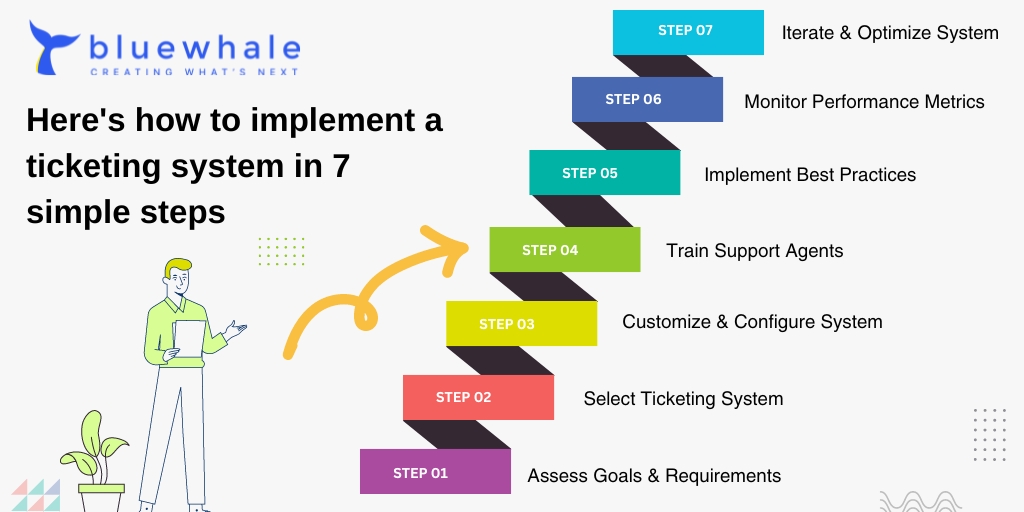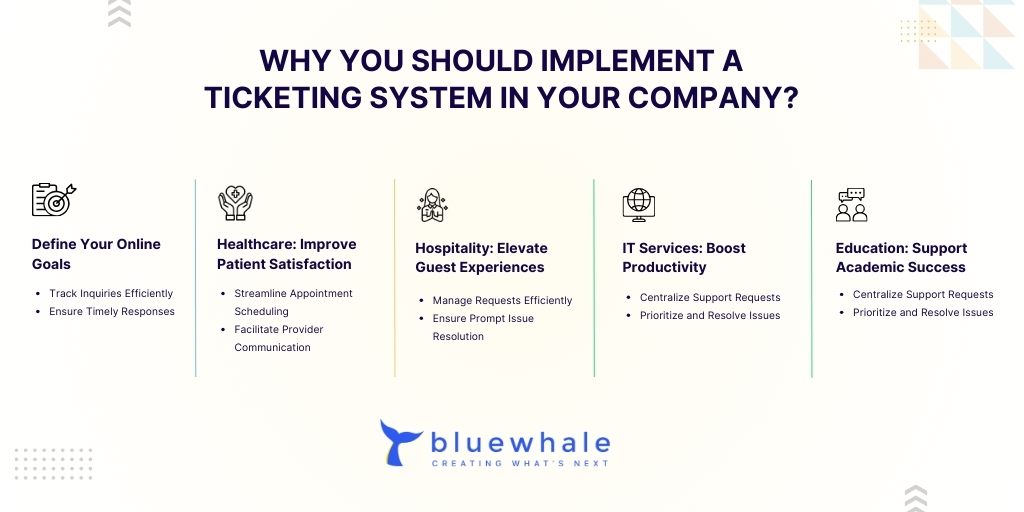Introduction
Managing customer requests efficiently is vital for a smooth-running business. Today, customers expect quick solutions to their problems. Studies show that speedy resolution is key to a positive customer experience.
So, how can businesses meet these expectations? One solution is implementing a ticketing system for customer service.
What’s a ticketing system?
It’s software that handles all customer inquiries, turning each one into a ticket. This system helps manage customer support faster and easier, with features like automation and team collaboration.
But implementing a ticketing system isn’t enough on its own. Customer service agents play a crucial role too. They need to follow best practices and prioritize, respond to, and follow up on tickets to enhance the overall customer experience.
Here’s how to implement a ticketing system in 7 simple steps:

Step 1: Assess Your Business Needs
Before choosing a ticketing system, figure out what your business needs. Think about things like response time, how quickly issues are resolved, and customer satisfaction. Consider factors like how much you can spend, how easily the system can grow with your business, and how it will integrate with your other tools.
Step 2: Choose the Right Ticketing System
With your needs in mind, pick a ticketing system that fits. There are many options, from basic help desk software to advanced customer relationship management (CRM) systems. Look at features, ease of use, cost, and how well the system can scale as your business grows.
Step 3: Customize and Set Up the System
Once you’ve chosen a ticketing system, customize it to match your business processes. This includes setting up ticket categories, defining workflows, configuring automation rules, and integrating it with other tools you use. Proper customization ensures the system works seamlessly with your existing processes.
Step 4: Train Your Support Team
Your support team needs to know how to use the new system effectively. Provide comprehensive training on the system’s features, ticket handling procedures, communication protocols, troubleshooting techniques, and how to use automation tools. Well-trained agents are key to a successful ticketing system.
Step 5: Implement Best Practices
To get the most out of your ticketing system, establish best practices. Set up standard operating procedures (SOPs) for handling tickets, define service level agreements (SLAs) for response and resolution times, and create escalation paths for complex issues. Consistently following these practices ensures efficient and consistent customer support.
Step 6: Monitoring and Analyzing Performance Metrics
Once the ticketing system is up and running, businesses should continuously monitor and analyze performance metrics to evaluate its effectiveness. Key metrics to track include ticket volume, response time, resolution rate, customer satisfaction scores, and agent productivity. By regularly reviewing these metrics, businesses can identify areas for improvement and implement strategies to enhance support operations further.
Step 7: Iterating and Optimizing the Ticketing System
Continuous improvement is essential for maintaining the effectiveness of a ticketing system over time. Businesses should solicit feedback from support agents and customers to identify pain points and areas for enhancement. Based on this feedback, iterative updates and optimizations should be made to the ticketing system to address shortcomings and capitalize on opportunities for improvement.
Why You Should Implement a Ticketing System in Your Company?

In every industry, from retail to healthcare, implementing a ticketing system brings a host of benefits:
- Retail: In retail, customer service is crucial for building brand loyalty. A ticketing system helps track customer inquiries, ensures timely responses, and resolves issues efficiently, leading to satisfied customers and repeat business.
- Healthcare: In the healthcare sector, patient satisfaction is paramount. A ticketing system streamlines appointment scheduling, tracks patient inquiries, and facilitates communication between healthcare providers and patients, ultimately improving the patient experience and healthcare outcomes.
- Hospitality: In the hospitality industry, delivering exceptional guest experiences is essential for success. A ticketing system enables hotel staff to manage guest requests, track service issues, and ensure prompt resolution, resulting in higher guest satisfaction and positive reviews.
- IT Services: In the IT sector, managing IT support tickets efficiently is critical for maintaining productivity and minimizing downtime. A ticketing system centralizes IT support requests, prioritizes issues based on severity, and facilitates collaboration among IT teams, leading to faster resolution times and improved user satisfaction.
- Education: In the education sector, providing support to students, faculty, and staff is vital for academic success. A ticketing system helps educational institutions manage IT helpdesk requests, track student inquiries, and provide timely support, enhancing the overall learning experience.
Regardless of the industry, implementing a ticketing system in your company can:
- Improve operational efficiency by streamlining support processes.
- Enhance customer satisfaction by providing timely and effective support.
- Increase productivity by automating repetitive tasks and workflows.
- Facilitate collaboration among team members by centralizing communication and information sharing.
Conclusion
In today’s competitive business landscape, delivering exceptional customer support is paramount for success. By implementing and optimizing a ticketing system, businesses can streamline their support operations, enhance customer satisfaction, and drive long-term growth. By following the comprehensive guide outlined above, businesses can master the art of customer support and elevate their service offerings to new heights.
At Blue Whale Apps, we understand the importance of effective customer support. Our team specializes in developing custom ticketing solutions tailored to your company’s unique needs.
Contact us today to learn how we can help you streamline your support operations and deliver exceptional customer experiences.




